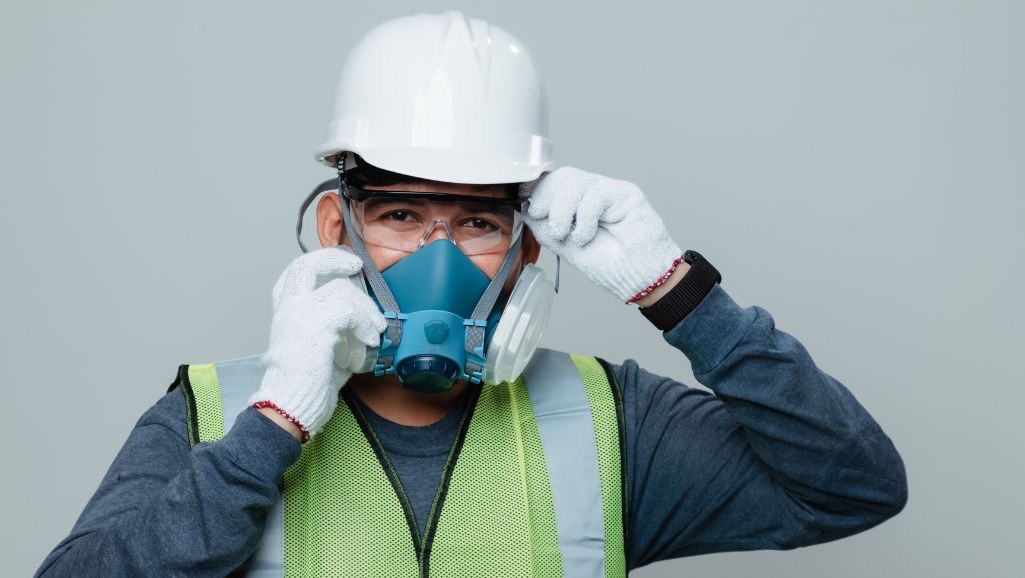 Complying with OSHA’s Respiratory Protection Standard will help keep workers safe, help you avoid fines, and lower Contractor Insurance costs. Construction workers can be exposed to harmful airborne contaminants, such as dust, smoke, gases, fumes, solvent vapors, and mists. These contaminants can cause respiratory issues, cancers, disease, or death.
Complying with OSHA’s Respiratory Protection Standard will help keep workers safe, help you avoid fines, and lower Contractor Insurance costs. Construction workers can be exposed to harmful airborne contaminants, such as dust, smoke, gases, fumes, solvent vapors, and mists. These contaminants can cause respiratory issues, cancers, disease, or death.
This is why NIOSH sets Recommended Exposure Limits (RELs) for airborne contaminants, and OSHA sets legally enforceable Permissible Exposure Limits (PELs) that employers must comply with.
Employer Responsibility
Employers are responsible for ensuring these airborne contaminants are eliminated, that engineering controls are in place, and/or that appropriate respiratory protection is provided. Employees need to be trained on the proper use, fit, maintenance, and storage of respirators.
OSHA requires employers to do the following:
- Ensure that only NIOSH-certified respirators, “with the proper design for the application,” are used
- Ensure that respirators are used and maintained properly
- Ensure that workers are not exposed to contaminants that the respirator is not designed to protect them from
- Keep track of respirators
Types of Respiratory Protection
“There are two main types of respiratory protection—air-purifying respirators (APRs) and atmosphere-supplying respirators (ASRs). Each respirator type provides a different level of protection based on its design.
Therefore, choosing the right type of respirator for the specific exposure is important. To do that, you must identify all respiratory hazards in your environment and the amount of exposure,” the Centers for Disease Control and Prevention (CDC) explains. “Additionally, each type of respirator has an assigned protection factor (APF). This indicates the level of protection you can expect to receive from that respirator.”
Air-Purifying Respirators
“APRs use filters, cartridges, or canisters to remove gases, vapors, aerosols, or a combination of contaminants from the air,” according to the CDC. They do not supply an additional source of oxygen.
Types of APRs include the following:
- Filtering Facepiece Respirator (FFR) – the most commonly used respirator
- Elastomeric half mask respirator (EHMR)
- Elastomeric full facepiece respirator
- Powered air-purifying respirator (PAPR)
Atmosphere-Supplying Respirators
“Atmosphere-supplying respirators provide clean breathing air from a source independent of the work area. These respirators will protect wearers from many types of airborne contaminants (particles, gases, and vapors) and, in certain cases, oxygen-deficient atmospheres,” the CDC explains.
Types of ASRs include the following:
- Supplied-air respirators (SARs)
- Self-contained breathing apparatus (SCBAs)
- Combination SARs/SCBAs
Silica Dust – The Most Prevalent Contaminant in Construction
In construction, silica dust, AKA respirable crystalline silica, is one of the most prevalent airborne contaminants. According to OSHA, approximately 2.3 million American workers are exposed to silica dust - a common mineral found in the earth and materials such as sand, concrete, stone, mortar, and stone. It is used to make glass, bricks, artificial stone, and more.
“Respirable crystalline silica – very small particles at least 100 times smaller than ordinary sand you might find on beaches and playgrounds – is created when cutting, sawing, grinding, drilling, and crushing stone, rock, concrete, brick, block, and mortar,” OSHA explains. ”Activities such as abrasive blasting with sand; sawing brick or concrete; sanding or drilling into concrete walls; grinding mortar; manufacturing brick, concrete blocks, stone countertops, or ceramic products; and cutting or crushing stone result in worker exposure to respirable crystalline silica dust.”
Concrete workers, masons, tile workers, road construction workers, site preparation workers, and drywall workers are most likely to be exposed to silica dust and, therefore, need to be protected from it.
“NIOSH recommends the use of half-facepiece particulate respirators with N95 or better filters for airborne exposures to crystalline silica at concentrations less than or equal to 0.5 mg/m3,” according to the CDC. “The Occupational Safety and Health Administration (OSHA) also specifies the use of at least a 95-rated filter efficiency [29 Code of Federal Regulations (CFR) 1910.134].”
Protect Your Workers and Your Business With the Right Contractor Insurance
The right insurance helps protect your workers and your business, but you don’t want to pay more than you need to. American Insuring Group is a Trusted Choice independent insurance agency. That means we can check the cost of your coverage with many competing insurance brands to ensure you pay the lowest premium.
Ready to save? Call us today at (800) 947-1270 or (610) 775-3848, or connect with us online.







